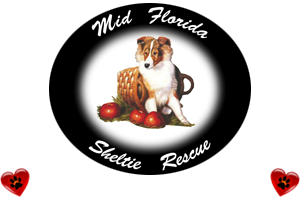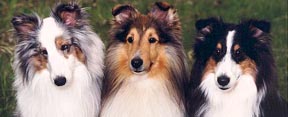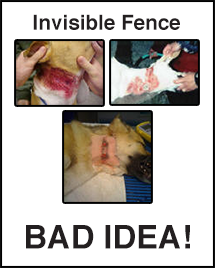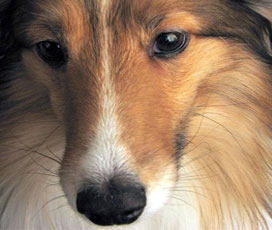Think you know Sheltie COLORS?
Temperament:
Although they can be a bit reserved with strangers, Shelties possess an intense desire to please their owners. They are highly trainable and very responsive, making them one of the top choices for many types of activities, such as obedience, herding, and agility. Shelties raised as pets develop a lasting loyalty to their families. Their propensity to guard their home make them highly protective, and most will bark when all is not right within their realm. Unlike some breeds, there is very little difference between male and female Shelties; either sex will make an exceptional pet.
Physical Features:
According to the breed standard, the ideal Sheltie should stand between 13″ and 16″ at the shoulder.
Colors:
There are three basic colors, all set off by varying amounts of white and or tan. The sable, ranging from golden brown to mahogany, with touches of black. Tri-color (black), Blue Merle (blue-gray, black), others are Bi-blue (blue-grey and black) and Bi-black (black and white).
Grooming:
The Sheltie’s double coat consists of long straight outer coat with a short, dense undercoat. The amount of grooming your dog will need will depend on the amount and type of coat it has, but as a general rule a weekly brushing should keep your dog in tip-top shape. You will need a slicker brush, pin brush, comb, nail trimmers and a scissors. A Sheltie coat should always be brushed or combed and should never be clipped down to the skin! Sharp nail tips should be trimmed frequently on a puppy; less often on an adult. Long hair may be trimmed on feet, ears and legs. Cleaning your Sheltie’s ears and brushing its teeth should also be part of its regular grooming routine.
Feeding and Exercise:
With proper nutrition , exercise and regular vet care, Shelties can have good longevity. Many dog food labels, both dry and canned suggest feeding far too much food for the average pet. Doggy treats can also pack on the weight and often contain high amounts of sugar, salt, dyes and chemical preservatives. Like people, an overly fat Sheltie can experience joint problems, diabetes and a myriad of other health issues. Shelties need a fair amount of exercise. Daily walks and active play sessions are encouraged to keep your dog fit and happy.
Invisible (Electric) Fencing
Invisible or electric fencing is a very popular fencing option that many of today’s homeowners are choosing. While there may be some aesthetic and cost benefits to this type of fencing, we in Rescue have discovered a great deal of problems related to safety, security, and humane treatment of the dog with this type of fencing, particularly with its use with a rescued Sheltie.
Because the Sheltie’s coat is extremely thick around the neck, in order for the electronic shock collar to be effective on a Sheltie, the shock level must be turned up very high and the length of the prongs must be very long. The high shock level and length of the prongs can cause pain and injury to the dog. Some dogs we have known have tried to scratch the shock collar off, catching their foot in the collar and getting burned and receiving puncture wounds from the prongs.
Another problem with the use of this style of fencing is that a dog will still run through the “fence”, accepting the first shock but refusing to return to the yard for a second shock. Shelties are very intelligent creatures. They CAN think and seem to understand cause and effect processes as it relates to their behavior. It does not take long for the average Sheltie to learn that if he received a shock leaving the yard, he’ll get another shock going back into the yard. The result is a Sheltie loose in the neighborhood, likely a new, unfamiliar neighborhood. The dangers of further injury and possible death are enormous.This leads us to yet another reason that the use of these fences with Shelties are a great concern. Rescued Shelties have lived in many different environments by the time they arrive into the Rescue program. Many have lived with several families during their lives, then find themselves either living by their wits alone on the streets or dumped in shelters. When they go to a new home, it will take quite a long adjustment period (several months, maybe longer) for them to realize and accept that this is finally their home. During that adjustment period, the risk of the rescued Sheltie trying to “escape” is great. An invisible fence will NOT prevent this.
Not only will an invisible fence NOT keep a dog in the yard, it will not keep another animal from coming into your yard and injuring or killing your dog. Nor will it stop a human from coming into the yard and stealing your pet, which happens every day.These are just some, but not all, of the reasons why we will not adopt a rescued Sheltie into a home in which the intent is to use an invisible fence.
Shaving a Sheltie
Often, people think a long haired dog should be shaved during warm weather. While on one level that may seem logical, but in reality, it is not wise to do so with a Sheltie. The Sheltie coat not only acts as protection against cold in the winter, it serves the same purpose in the summer, protecting the Sheltie from the heat.
The Sheltie coat also protects against parasites such as fleas, ticks, mosquitoes. That’s not to say a Sheltie never encounters these parasites, but that thick coat does slow those critters down. Another advantage to the Sheltie coat is that it repels dirt. Get rid of that coat and you’re inviting dirt to attack your Sheltie and cling to its skin. Also, the Sheltie coat helps to prevent that “doggie odor” that so many breeds have. Shelties don’t typically have a “doggie odor,” partially because of the coat. Take that coat off and the Sheltie may begin to smell like a dog.
While shaving may be necessary for medical purposes, such as in preparation for surgery, shaving just for convenient coat care should be avoided. Shaving too close can cause medical conditions from something as common as razor burn (which hurts like the dickens) to more serious damage. Some damage can be permanent, such as damage to the hair follicles. The fur may grow back in patches, leaving the Sheltie bald in various places all over its body, or the fur may not grow back at all. If the care of coat is inconvenient or too difficult, reconsider if the Sheltie is the right breed for you. That luxurious coat is what makes a Sheltie a Sheltie. They know they are beautiful with that gorgeous coat. Most Shelties have actually acted embarrassed after being shaved. So, for the health, beauty, and pride of your Sheltie, please don’t shave.




